 |
 |
| . |
| . |
| . |
| . |
| . |
| . |
| . |
| . |
| . |
| . |
 ... ...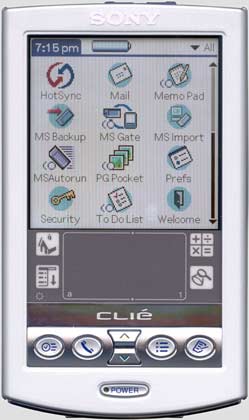 ... ...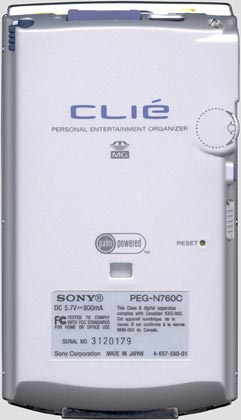 |
|
|
| .
Like every Palm-OS driven PDA, the Clié has the typical hardware buttons in the typical locations. Though, the power button moved to the center of the unit all the way to the buttom. A tiny green LED in the power button indicates, that the Clié is running. Considering the 'HOLD' mode of the Clié, the LED makes sense. More about that a bit later. The application buttons are ok, but the scroll buttons are too hard to operate. Especially scroll up is really hard to press, partly because it's too flat. The reason for Sony to make the scroll buttons so flat and so hard to press was probably to prevent accidental operation when the unit is closed and sitting in your pocket. Palm has painful experiences with this matter. Additionally the Clié has alot of Sony typical details: On the left side the jog wheel, a 'back' or 'escape' button and the also Sony's typical 'HOLD' switch. As an external memory expansion, the Clié uses of course Sony's very own Memory Stick, right beside the IrDA window on top. . But so far we didn't talk about the two real goodies of the Clié 760: The screen and the audio. The LCD shows 320x320 pixels in 65.000 brilliant colors and in the moment, it's for sure the best display you can get in a Palm-OS PDA. Although the Clié is narrower than an m505, the active screen size is exactly the same, the frame around the screen is just a little smaller. More about the screen in its own section. Apart from the usual Palm-style piezo speaker for alarms and system sounds, the Clié 760 has a dedicated stereo output for playing back MP3 and ATRAC encoded files. You'll even find a nicely designed headphone and a cable remote along with an 8 MB memory stick in the default supply. Just enough to try everything right out of the box. But the audio capabilities are also worth an own chapter further down. Let's finally look inside the Clié ... . |
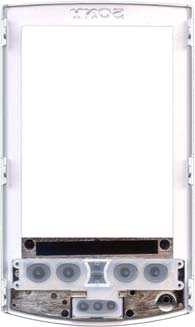 . .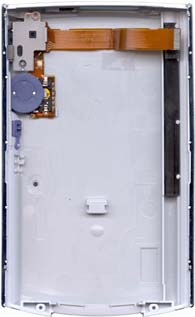 . .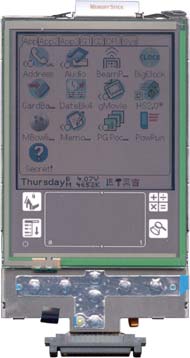 . .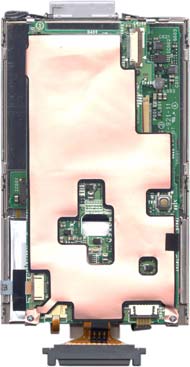 |
| .
The Clié is build like you would expect it from Sony. A high integrated modern design and quite rugged. In fact the plastic case is only a cover. Actually a stable steel frame protects and holds the main PCB and the screen. Sony's long time experience in designing and building mobile devices is clearly visible. . |
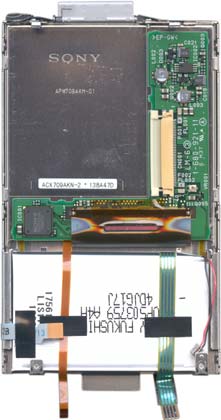 ... ... ... ...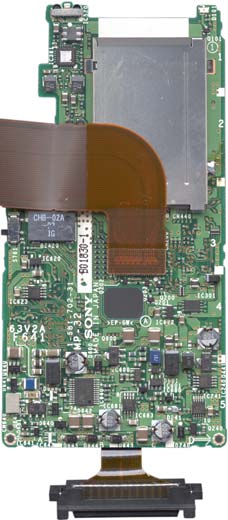 |
| .
After seperating the two layers - screen and main PCB - the Clié reveals quite some complexity. Like all Palm OS devices (in the moment), the Clié uses a Motorola Dragonball as the main processor. Sony also picked the 33MHz VZ type for their top model. Also Palm OS typical are the 8 MB RAM, the 4 MB Flash (to fit OS 4.x plus some Sony applications) and all the peripherials like IrDA, serial port and USB. Interestingly, there's room for another Flash chip on the main PCB. Either Sony wasn't sure to fit the OS and all their apps in the existing 4 MB, or they just reserved their chance to use also two 2 MB chips. Anyway, the space could be probably used to extend the Flash to 8 MB which makes alot of room for tools like FlashPro or Jack Flash (unfortunately FlashPro is not supporting the Clié up to now). Though, I'm not sure whether adding another Flash chip would be enough, since there's also empty space for some additional decoder chips which might be necessary. . But the complexity of the Clié is made by two more high intergrated chips on board: One is the MQ1100 MediaQ controller which is a dedicated display and peripherial co-processor for the highres screen and it handles also the USB interface. The chip contains even more, but it's not 100% used in the 760. But already the USB implementation is worth a closer look, since there is a small but important difference compared with the USB port in the Palm m-series. USB connections are so called endpoint connections between a host (usually the PC) and a device (web cam, mouse etc.). You can't connect two devices, there has to be a host. The Philips controller in the Palm is only able to establish a connection as a device. So the Palm can only talk to a host, typical peripherial devices can't be used with the Palm. The MediaQ controller in the Clié can act as host or device. In other words, provided the right drivers are available, the Clié could talk to any USB device. . The second LSI is the Sony CXD-1859 which is a very special audio controller that also takes care of the Memory Stick interface. That combination enables the Clié 760 to play back audio even in the background, since the hardware does most of the work. That chip also contains all the digital right management which seems so important nowadays for the poor, always betrayed right owners like Sony music. In other words, there is only one chip between encrypted data on a Memory Stick and the audio output - hard to hack! There's not much informations available if you're no member of the exclusive memory stick developers 'club', not even a datasheet of the chip. I only found a brief overview of the functional blocks, but that should do it for this review (no highres version, sorry <g>). . |

. |
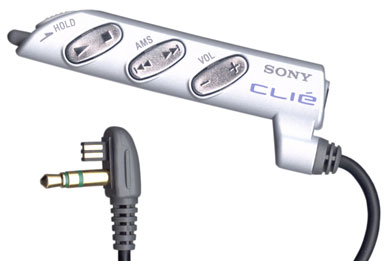 ... ...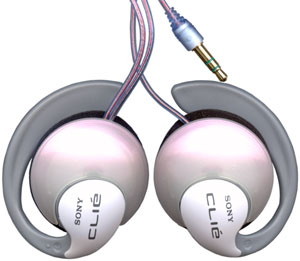
. |
| The headphones not only look good (kind of mother-of-perl finish),
but have also a nifty way to go on the ear. A springloaded 'earpiece' holds
each speaker comfortably in place, tight enough to go jogging with them.
The sound is above average considering the normally supplied headphones.
They plug into the remote control which again plugs into the Clié
with a proprietary extented stereo plug for the additional remote signals.
If you don't need the remote functions, any standard 3.5mm stereo plug
goes also in the Clié directly. All in all a very 'Sony-like' solution,
nice and well working.
. Another application Sony packed into the Flash is the audio player. It's probably the nicest application on the Clié and handles all MP3 related matters. It plays MP3 from RAM or directly from a Memory Stick. It also plays ATRAC encoded files, but only from a special, white Memory Stick type named 'Magic Gate'. The Magic Gate stick is basically Sony's version of the SD-Card and has an integrated right management. Although ATRAC offers presumely MP3 quality at an even lower memory consumption, I never tried it. I'm strictly against the agressive attempts of the industry to control more and more when I'm allowed to listen to what music on what device. Understand me right, I never ripped illegally a single MP3 file, but I own quite a few CDs I collected in my not so short live so far. Most of the artists and studio bosses that got my good money for these CDs are getting bigger pay checks than I get, and so the least I can ask for is to be able to copy, mix, recompile and convert that music collection as often and as free as I think it's convenient for me. I want to burn a collection for my car, copy them to a minidisk for travel or convert them to MP3 for the Clié. In the end it's always only me listening to it with my very own 2 ears at a time. So I'll never buy a Magic Gate stick and use a 128 MB standard Memory Stick for MP3 only instead. . The transfer of MP3 files (but not only MP3) is very convenient once you installed an extra USB driver on your PC. Apart from the usual Hotsync protocol which is quite slow by definition, Sony implemented an additional file transfer protocol which lets the Clié basically act like the usual USB-card readers. The function is activated either in the audio player menu or with a standalone application called 'Import'. It establishes a connection with the PC and the memorystick appears as a drive on the PC with all the usual explorer functionality. That's not only more convenient, it's also much faster than the Hotsync protocol. One hour of MP3 music (encoded with 128kbit/sec.) takes only 2 minute to transfer. . So once everything is in place, launch the Audio Player which is also residing in Flash. It's a beautiful app with all the standard MP3 options. It shows ID3 tags, can shuffle titles and handles whole albums. But the real surprising thing is, it can play music in the background and it doesn't even slow down the Clié a lot. But first the background operation has to be enabled in the player preferences, after all a little system perfomance penalty has to be payed. In numbers: Benchmark 2.0 rates the Clié normally with 212% (relativ to a Palm IIIxe). When the background playing is just enabled but no music is playing, the rating drops to 198%. When the player is busy playing an MP3 file, the rating is dropping to 187%. Considering the Clié is anyway quite fast, the speed penalty is well worth the ability to listen to music while doing other things. In my opinion there's only one logical flaw: System sounds are also played back through the headphone and apart from the usual Palm OS option to disable the sounds completely, the Clié OS has no possibility to seperate that sound path to the headphone. So playing a game with lots of sound while listening to MP3 is only possible if you mute the game completely or if you're enjoying alot of additional beeps in your favourite tune. IMHO, Sony just forgot a control that cuts off the headphone output from the system sounds and leave them on the piezo only. . While listening to music, you can also put the Clié into a special sleep mode with the HOLD key. In that mode, the LCD is off and the power consumption drops considerably. Sonly claims 11 hours of continuous operation in that mode. The cable remote remains still functional, unless you lock it with its own HOLD switch. . Unfortunately Sony didn't implement any sound recording capabilities. This is a great pity, since the sound chip in the Clié has alot of encoding capabilities too and I doubt anyway, that it was always that clear for Sony's engineers that no sound recorder will make it into the Clié. If you're looking a bit closer at the upper case lid, you'll find a hole in the plastic just in the right place (seen from behind, right/down) and just made to take a little microphone like the ones used in mobile phones. That dent has no other function. But in the moment at least, the Clié can't record sound (like the HandEra 330 for example, naming a PalmOS device that can). . For the curious of you, below is an image of the remote PCB. No big deal, just some buttons and (I assume), some 'encoding' resistors. . |
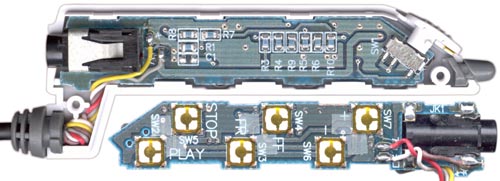 |
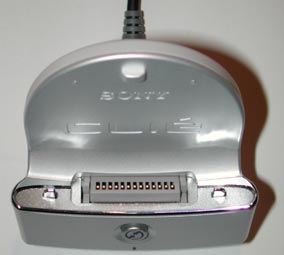 . .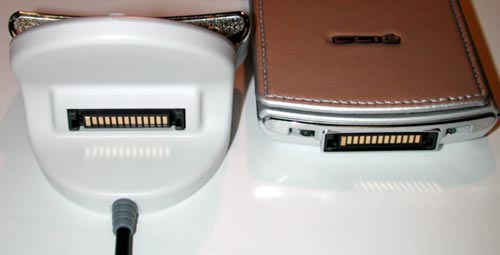 . . |
| .
The Clié cradle is a beauty and has a very small footprint. Unfortunately its a little bit too light. The Clié slides in nearly by itself and snaps into a tiny nose on the cradle, so far so good. But when you want to take it out, the cradle is light enough to stick to the Clié. So either you 'rattle' a bit to get rid of it, or you hold it down on the desk with your other hand. Another strategy is, to press the Clié down a bit first and tilt it to the front so it comes loose from that tiny 'nose'. . |
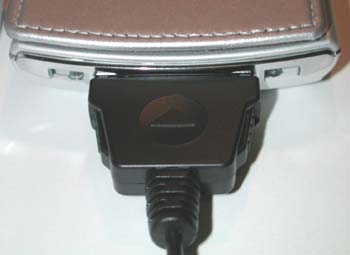 . .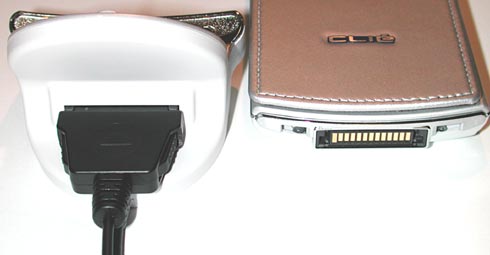 . . |
| .
Of course there's the usual hotsync button and a green LED, indicating the Clié is connected and externally powered. Unfortunately the light does not indicate when the battery is full, it's on as long as the device is powered. The Clié comes with a USB cradle. If you need RS-232, you have to order an extra cradle or you can modify the USB cradle with the same trick that worked already for the Palm m505. On the table below you'll find all the signals on the Clié connector. . |
|
| Most of these signals are self explaining and very similar to the Palm
m50x series. The Clié also identifies the hotsync port (USB or RS-232)
by a resistor value between pin 12 and GND (pin 13). For USB, the resistor
has to have a value of 220 KOhm, for RS-232 it's 47 KOhm. For modifying
the USB cradle, it's nice that the RS-232 value is lower since you just
can add a resistor in parallel to the existing 220 KOhm one to bring it
down to 47 KOhm instead of replacing the tiny part completely. In case
you're not familiar with these kind of calculations, 60 KOhm would be the
right value to put across the 220 KOhm. But that's a very unusual value,
a 62 KOhm resistor is much easier to get and would it work just work fine.
62 KOhm and 220 KOhm result in 48 KOhm which is good enough. Of course
you still have to add the serial cable to the right pins and an optional
switch to use RS-232 and USB alternately. Now that again is much harder
on the Clié cradle, since there's much lesser room. If I ever go
for the mod, I'll post it here.
A little unusual is the power output on pin 11. It's not regulated and coming right from the Lithium Ion battery which voltage swings between 3.4 and 4.2V. So any accessories supplied by that pin should be able to handle that. Needless to say, that this pin should also be handled with care. A short to ground might have fatal defects! . |
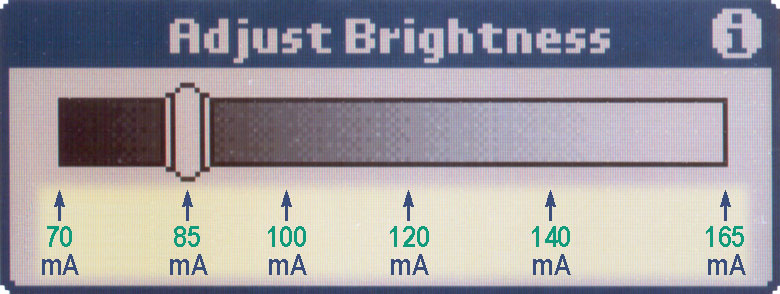 |
| .
Set to the lowest brightness level, the Clié needs only about 70 mA. On that level, the Clié screen is clearly darker than a 505, but especially in the night that's not only saving power, but it's also more comfortable for the eyes. In my subjective opinion (I just guessed with the two devices side by side), the slider position on the above image is the right setting for the Clié to meet the brightness of an m505. Then the Clié consumes the same than his collegue from Palm, but don't forget, its battery has nearly double the capacity. In other words, a Clié on the same brightness setting than an m505 works nearly twice as long. The consumption increases quite linear over the slider range, but IMHO from the 140 mA mark on, the brightness increases much lesser than the consumption. I personally think, using a higher setting than about 2/3 to 3/4 is a pure waste of energy. A thumb rule for the operation time is, to devide the 1000mAh by the current value on the slider scale. All these calculations are disregarding of course any additional power drain for heavy calculations, lots of grafitti action and of course games. But that's true for both units and the idle consumption is the only way to get comparable values. . I guess a real unique feature of the Clié in the Palm OS world needs some more explanations in the power consumption section: The HOLD mode. Probably introduced and most usefull for the MP3 player, it can be used anytime with any application. Operating that little sliding switch on the left side basically shuts off the screen and locks all buttons. But the processor keeps running, as well as any running application. In that mode, the Clié saves quite some power, after all the screen is - depending on the backlight setting - a big power drain. Because of the HOLD mode, the little green light in the power button makes sense too. It stays on when the Clié is put on HOLD while it was running. As mentioned, basically any application could go on working without the screen and such saving power. Though, right now I can't think of any other application than the MP3 player that could do something useful without the screen. By the way, even the auto-power off timer is working in HOLD mode. If no running application is preventing auto-power off (as the MP3 player does of course), the unit powers off completely as usual. Since the screen is already off, only the little green light goes off then. If an alarm goes off in HOLD mode, the Clié powers on only very shortly and goes back in HOLD mode right after the alarm sound is played. But the green light in the power button stays on until the auto-power off time is over - that's a kind of logical behaviour. . A standard for PDAs with rechargeable batteries seems to become the inbuilt charger logic. The Clié makes no difference and so it's enough to supply simply a stabilized voltage. But unfortunately, Sony picked the real wierd external voltage of 5.7V for their external power supply. So if you plan to build your own second power supply or a car supply, keep in mind that the usual 5V circuits won't do it. Supplying the Clié with 5V only results in no charge at all when it's on, and a incomplete refill when kept off during the charge period. No good idea. But the supplied 'wall brick' is a nice one. It's a small, lightweight switched type with an input voltage of 100-240V, so you can use it anywhere in the world. Its output current rating is 800mA, that's about the max. a Clié would consume when it's in use and a relatively empty battery is charged at the same time. As with all LiIon batteries, the charge current is high at the beginning of the charge cycle and tends towards 0 when the battery is full after about 2-3 hours. Because of that non-linear charge current, the cell refills already in the first hour to over 50% of its capacity, provided it was nearly empty. . |
 . . |
.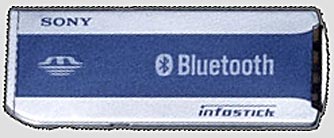 |
|
. Last updated: February 6th, 2002 Copyright © 1997-2002 by Peter Strobel, all rights reserved. |